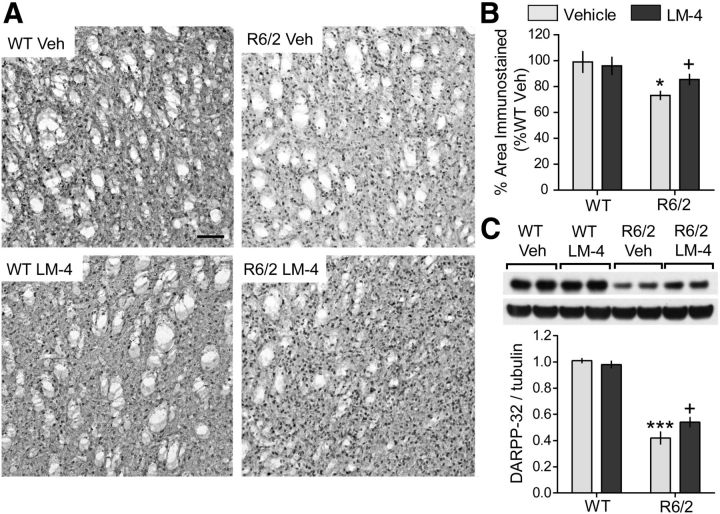Figure 4.
Decreases in striatal DARPP-32 levels are ameliorated by LM22A-4 in R6/2 mice. A, Representative DARPP-32 immunostaining in striatum of WT (left) and R6/2 mice (right) treated with vehicle (Veh; top) or LM22A-4 (LM-4; bottom) is shown. Scale bar, 80 μm. The immunostaining appeared lighter, especially in the neuropil, in R6/2 mice given Veh (n = 10) compared with the WT veh (n = 12), WT LM-4 (n = 10) and R6/2 LM-4 (n = 13) groups. B, Quantitative analyses showed that the decrease in area occupied by DARPP-32 immunostained cells and processes in Veh-treated R6/2 mice (*p ≤ 0.05 vs WT Veh) was prevented with LM-4 treatment (+p ≤ 0.05 vs R6/2 Veh). The area occupied by the immunostained cells and processes was expressed as a percentage of the total area analyzed and normalized by the WT Veh group. C, Representative Western blot of striatal homogenates from 11- to 12-week-old WT or R6/2 mice treated with Veh or LM-4 shows that DARPP-32 protein levels are decreased in the R6/2 Veh group compared with WTs (***p ≤ 0.001) and that LM-4 ameliorated this deficit (+p ≤ 0.05; two-tailed Student's t test). Immunobands from two mice per group are shown. For quantitation, samples from each mouse (n = 8–10 mice/group) were run in triplicate, values were normalized to the WT Veh group, and runs for each mouse were averaged. Results are expressed as mean ± SEM. Statistical significance was determined by ANOVA and Newman–Keuls post hoc test, unless otherwise noted.

